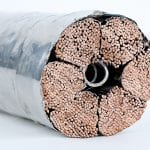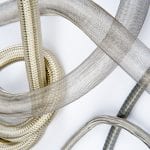Ocean-Going UVs
These UV’s find use in government and military applications, in academic and scientific research, in hydrographic surveys and a wide range of commercial applications.
They can be built to run autonomously without human control, operated by software and constant updates from sensors that monitor the watery environment; or, as ROVs, may be tethered to an umbilical and kept under remote control. The market for undersea UVs is expected to grow at about eleven percent through the end of the decade. Many are used in offshore exploration for oil, gas and mineral exploration as well as maintenance of underwater machinery.
For example, the SAAB SeaEye manufactures a family of remotely operated vehicles used for inspection and manipulation of underwater machinery. Such vehicles are equipped with multiple video cameras, lighting, sonar, probes, manipulators and in some cases, a fiber optic link to the surface.
The US Navy is working toward a fully autonomous submarine, not so conveniently named LDUUV (Large Displacement Underwater Unmanned Vehicle). While it’s not operational yet, a prototype was successfully tested earlier this year.
Another interesting ocean-going UV actually swims along the surface of the ocean. The emission-free Wave Rider by Liquid Robotics uses wave-power and stored solar energy to navigate. It floats on the surface, moving with the waves, while a tethered component that looks much like a glider with a dozen wings captures wave energy several meters below the surface. To date Wave Rider has traversed the entire Pacific Ocean autonomously. Read more here.
Aerial UVs
Drones are in the news, both due to their military applications, and because quadcopter-type drones are flooding the civilian market causing the FAA to set rules that govern their use. Overall, UAVs are expected to grow between 18 and 30 percent (CAGR) through the end of the decade, with worldwide sales of military and civilian UAVs reaching around $14 billion by 2025.
Military drones incorporate computers, GPS, video capture, communications and weapon systems along with high resolution cameras for surveillance and target acquisition. Long- and medium-wave infrared cameras capture imagery without external illumination; the cameras detect IR radiation emitted by the target itself.
In the civilian space companies like Event38.com manufacture UAVs used in 60 countries to monitor crops. Their E386 agricultural UAV can fly for 75 minutes and map 750 acres in a single flight. The company developed agriculture-specific apps that give growers analytics for more effectively managing their farms. Raw video data collected is transformed into geo-referenced maps. Using cloud-based services, growers can view maps online or download them for use in areas of current interest.
Civilian UAVs have found use in these and other applications:
- Environment conditions studies
- Wildlife populations surveys
- Land use and geological surveys
- Archaeological site mapping
- Inspect electric power and communication towers, buildings, bridges and other structures
- Support for fire-fighters
- Environmental disaster monitoring
- Search-and-rescue
- Traffic accident response
- Urgent delivery of medicine
- Tasks too dangerous, expensive or unpleasant to do manually
Ground UVs
UGVs operate in contact with the ground. They observe the environment and terrain in order to navigate autonomously—or may operate under remote control by a human operator. Military uses include supplying ammunition, rescue operations and detection and detonation of explosives. However civilian use for UGV’s is burgeoning.
Companies like Clearpath Robotics manufacture a family of autonomous UGVs. Their “Jackal,” a small, autonomous research model with onboard GPS, computer, Bluetooth, Wi-Fi and other components is powered by a range of battery options and travels at about 2 MPH.
According to market researcher ReportsnReports.com, the worldwide unmanned ground vehicle market will grow at around 30 percent compound annual growth rate to 2019.
Holding It All Together…
As technology continues to advance, UVs of every description become more and more sophisticated. Maintaining reliability and long MTBFs depends on subsystems communicating flawlessly with one another. Cabling systems fulfill that role, but the environments in which UVs operate often require custom-designed and special purpose cable systems.
For example, with most UVs having articulated components, high flex multi-conductor cables are needed to connect subsystems. Heavy duty cabling is required for power transmission, while twinax and coax are used to carry video signals and to protect against electromagnetic interference. Multi-conductor, twisted pair and similar cabling systems transmit data and provide sensor feedback from altimeters, gyroscopes and GPS receivers to control systems.
New England Wire, is an ISO 9001-2015 registered manufacturer of custom wire and cable products. For over 120 years the company has specialized in custom cabling systems for the most demanding applications. Today the company supplies special and custom-designed cable systems to worldwide customers in the UV industry.
Advances in electronics, integration and software initially developed for military UV applications are being adapted and transferred to civilian markets. Just as GPS was initially a military-only technology, once it was released to the civilian market it became ubiquitous and spawned many companies making GPS products for surveying, traffic control and geolocation. In the same fashion, unmanned vehicles have already given birth to new companies, and the dollar value of UVs sold into the civilian market will dramatically overshadow those sold to the military.
Custom Design

About Our Engineers
Innovative solutions start with an experienced team of engineers, armed with the latest design tools and technology. Our focus on understanding the individual, complex challenges of our customers and designing solutions that fit, is why we have been trusted as the industry leader for over 100 years.


















